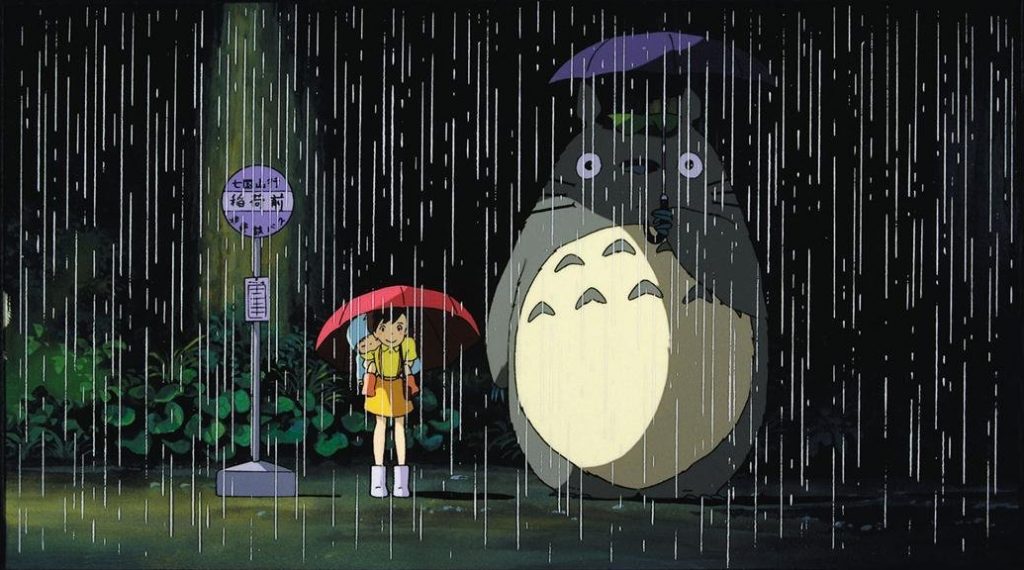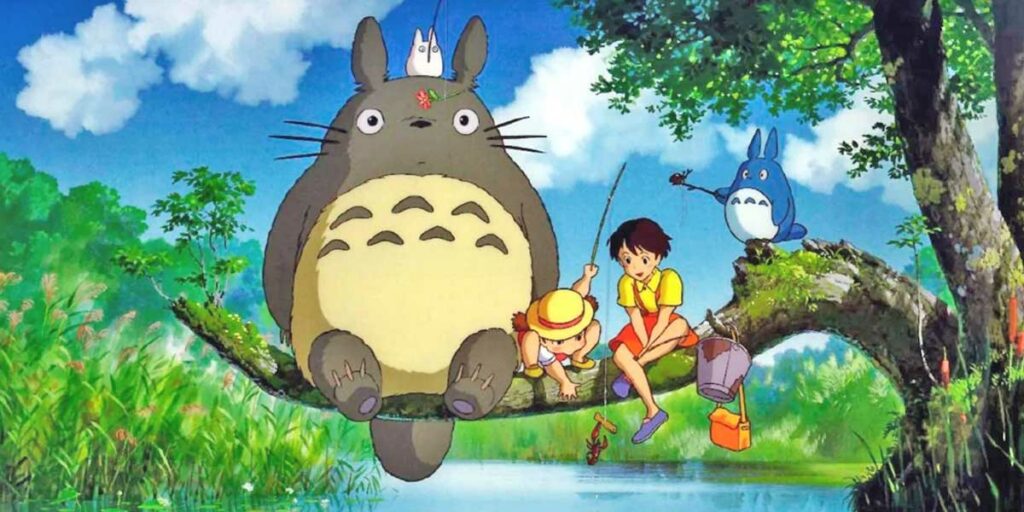My Neighbor Totoro may not be Hayao Miyazaki’s best film, but this family fantasy set the stage for what Studio Ghibli could be.
Hayao Miyazaki is one of our greatest artists, and My Neighbor Totoro (1988) was the first giant leap in his career. This unassuming, optimistic family film does not reach the heights of Miyazaki’s most ambitious works, but it tells a simple story that has impacted young and old viewers for a generation. The film’s story follows Tatsuo (Shigesato Itoi) and his two young daughters, Satsuki (Noriko Hidaka) and Mei (Chika Sakamoto), as they move into an old house to be nearer to the girls’ mother, who is in the hospital battling a long illness. The children discover various spirits at their new home, including a large, animal-like spirit Mei names Totoro (Hitoshi Takagi). The children’s newfound friendship with Totoro helps them through the traumas of their young lives while helping them embrace life’s beauty.
Any discussion of Miyazaki, Studio Ghibli, or My Neighbor Totoro needs to begin with the quality animation. Miyazaki and Ghibli are known for a beautiful 2D animation style that focuses specifically on shots of nature. The nature shots in Totoro are some of the best in Miyazaki’s catalog, which helps fuel his common theme of caring for and preserving the natural world. Whether it be shots of rain while the girls (and Totoro) wait for a bus, or a shot of the large creature napping peacefully in a forest of green, Miyazaki’s eye for capturing nature is unparalleled.
What’s also striking about Totoro’s animation is the attention to detail Miyazaki infuses into the frames. The particulars are not overlooked; they are emphasized. These small details, like the soles of the girls’ bare feet being covered in dirt as they run through the new home, not only show Miyazaki’s punctiliousness, but they also serve narrative and thematic purposes. To use the dirt example, the girls discover “soot sprites” after exploring the house, spirits that, according to their new neighbor, are the explanation for the dirt. These spirits and others throughout the film serve as a metaphor for childlike imagination. The elder neighbor (Tanie Kitabayashi) even says this to the girls when they discover their dirty hands and feet, saying “I used to see them when I was your age.” Miyazaki places details like this into this film constantly. He establishes the detail early on to seamlessly connect his grander themes.
The creature designs themselves are also worthy of note. While not as complex as those seen in other Ghibli films, the soot sprites, Totoro, and the faction of phantasms throughoutthe film are some of the most recognizable in animation history. You’d be hard-pressed to find someone who doesn’t find Totoro adorable, and the Catbus (Naoki Tatsuta) is a great example of Miyazaki’s ability to blend interesting character concepts with narrative functionality, being used as a plot device to transport the two children throughout the story. All of this goes back to the filmmaker’s knowledge of what works, what doesn’t, and what the best visual representations should be to tell the story effectively.

I want to acknowledge that my main criticism of My Neighbor Totoro is not going to be a fair one. Having seen some of Miyazaki’s other great works before Totoro (Spirited Away, Howl’s Moving Castle), I was taken aback by this film’s simplicity on first viewing. The story is rather straightforward and stops its momentum once Totoro appears. While not every story needs to have the ambition of Spirited Away or Princess Mononoke (my two personal favorite Miyazaki films, because of that more prominent sense of adventure and ambition), one may find themselves saying “oh, that’s it?” at this film’s conclusion. The movie forgoes narrative buildup for a more emotional third act, one that succeeds in drawing out emotion but feels like it doesn’t truly finish the story, the journey on which the rest of the film takes Satsuki and Mei.
Another issue here is the balance between the more thematic, dramatic elements and the upbeat, fantastical moments. The back half of the film focuses primarily on the health of Satsuki’s and Mei’s mother. The girls learn that their mother has taken a step back in her recovery process, leading to the film’s climax where Mei gets lost on her way to the hospital. Miyazaki does not fully lean into the sense of dread and fear the girls were feeling. While they ask if their mother is going to die, the movie never really gives its audience any indication that this could be a possibility. Any conflict in the film is quickly resolved (the girls quickly learn that their mother has only a cold and is still recovering at a good pace). It feels like Miyazaki (whose mother also suffered from a long illness) worried about the more mature moments in this movie and attempted to dial them back. Miyazaki would correct this in his later works (including this year’s wonderful The Boy and the Heron, where his mother’s backstory also serves as key inspiration).
My Neighbor Totoro remains an important film; there is no denying this simple fact. The film is beautiful, unassuming, and touching. Without it, Studio Ghibli may not have the cultural status it does today. Its achievements are important, even if it does not reach the lofty heights of other Miyazaki masterpieces.
My Neighbor Totoro is now available to watch on digital and on demand. The film will be re-released in cinemas across the UK and ROI from August 2, 2024. Read our ranking of all Hayao Miyazaki films!

